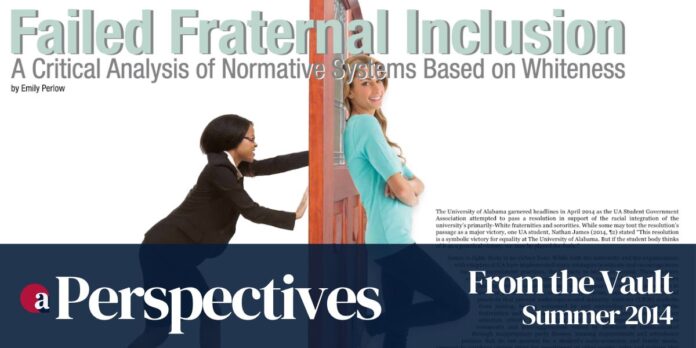This is a republication of an article first published in Perspectives in Summer 2014. The author has provided the following reflection on the article, as well as additional references:
- Since it was published 10 years ago, do you have any reflections on this article today?
Given the extreme polarization happening in our country right now, particularly around critical race theory, if I were writing this article today, I’d suggest the same need to build more accessible and equitable environments, but I’d construct my arguments a little differently. Unfortunately, the term “Critical Race Theory” has not aged well. Folks who hear it, and do not know what the framework is about, assume use of the term “critical” means judgment, rather than analysis.
The conversation does not need to change; the nomenclature needs to shift. Lately, I have been thinking about approaches to equity work that apply universal design principles, which advocate, according to The Center for Universal Design (1997), for “the design of products and environments to be usable by all people, to the greatest extent possible, without the need for adaptation or specialized design” (para. 7). The concept, applied often to designing physical spaces so that all bodies can access them, applies to other forms of equity work too.
Imagine if we used universal design principles to identify and address environmental barriers that affect students of all identities. Much of what we do in higher education is to identify obstacles for student populations and then design customized interventions for that specific student population. Instead, imagine a world where rather than building supports to navigate barriers, the barriers are identified and removed. It is not about designing special processes, systems, or programs, but instead, designing the environment to serve everyone well.
I believe the work ahead remains the same. Systems and structures continue to disadvantage some of our students. We must constantly scan the environment so that we see where these systems and structures function. It is critically important, now more than ever, that we continue talking about the need to create a world designed to serve everyone. We must take actions that help achieve that reality.
- How do you think social activism plays into your article?
Social activism is at its root about creating change and that was my goal with this article. I take the position in this article that a lot of change is performative and fails to address the systems and structures that create meaningful improvements. Ten years later, we are still struggling with the same thing. While there are some improvements, the barriers to access fraternal experiences still exist. The systems for joining, belonging, and engaging must continue to change.
True activism means being committed to the work, even when it is hard. Too many students take stances for social media likes or to join the bandwagon by signing the petition of the day rather than because they are truly committed to the cause. Simultaneously, there are also far too many well-meaning students with dominant identities who speak for their diverse peers rather than creating space for their diverse peers to have voice. I think it is important we help students see the distinction.
Second, students are too quick to cancel one another. We need to work more at calling people in rather than cutting them out. This is, in my opinion, one of the reasons we have become so societally polarized of late. We must teach students how to engage in controversial conversations with civility.
Finally, it is important we role model to students how to make impactful organizational change that does not always take a “burn it down” approach. We can show students how to interrogate systemic assumptions, how to lead with influence, and how to bring data and cogent arguments to discussions with those who have institutional change-making authority. It is these skills that students take with them into the greater domain, equipped with even more ability to make the change we need in this world.
ORIGINAL ARTICLE:
Failed Fraternal Inclusion: A Critical Analysis of Normative Systems Based on Whiteness
The University of Alabama garnered headlines in April 2014 as the UA Student Government Association attempted to pass a resolution in support of the racial integration of the university’s primarily-White fraternities and sororities. While some may tout the resolution’s passage as a major victory, one UA student, Nathan James (2014, ¶2) stated “This resolution is a symbolic victory for equality at The University of Alabama. But if the student body thinks of it as a practical victory, we may be played for fools.”
James is right; there is no victory here. While both the university and the organizations with chapters at UA have implemented many strategies to educate and encourage more inclusive recruitment practices, the barriers to inclusion persist. These barriers exist across fraternity and sorority communities nationwide. There is no victory in passing a resolution or changing a few small practices that open a pipeline, only to have that pipeline become clogged by the norms, assumptions, policies and practices that prevent underrepresented minority students (URM) students from joining, feeling welcomed by and succeeding in primarily-White fraternities and sororities. Examples of these barriers include member selection criteria that privilege White student experiences, insensitive comments and microaggressions voiced by members or communicated through inappropriate party themes, housing requirements and attendance policies that do not account for a student’s socio-economic and family needs, pressure to purchase certain attire for recruitment or other events, rules and policies that ignore or suppresses cultural differences, and an emphasis on social status and appearance that that prioritizes Whiteness.
It is time to confront the reality. Assuming the exclusion is remedied by attracting a few members with intersectional identities is arrogant and a mark of White privilege. While the spotlight focused attention on equal access to fraternal membership at The University of Alabama, nearly every college campus and every historically-White fraternal organization needs to confront the harsh reality that ideological assumptions and norms embedded in the fraternity/sorority experience prevent and inhibit URM student inclusion.
Critical race theory
Critical Race Theory (CRT), guided by five main assumptions (Solorzano, 1997), provides the framework to interrogate and transform structures, assumptions and norms that privilege some students in fraternities/sororities and reinforce unequal access for others.
- CRT premises that racism is a regular commonplace, prolifically present and deeply entrenched experience that pervades our everyday lives (Habermas, 1987).
- Race is socially constructed as a tool to separate the haves from the have-nots. This social construction can be deconstructed by challenging the norms and assumptions that influence everyday decisions.
- Society has established a White vs. other-race binary that privileges Whiteness and grants benefits to those with privilege including access to education, wealth, and resources that further enhance accumulation of additional privilege. Membership in a fraternity or sorority and its associated networks, mentoring and leadership development are an example of this privilege.
- Because those in privileged positions have the ability to establish policies and practices, these policymakers often unintentionally marginalize URM voices. CRT gives voice to marginalized races through counterstories (Espino, 2012), those stories have not been part of the mainstream culture.
- To break apart the hegemony of racism requires a collaborative approach. As fraternity/sorority professionals, we must challenge racism across institutions and organizations, including many of the practices and processes associated with fraternity and sorority life.
To challenge racism requires us to first confront two important ideological assumptions: the notion of equity versus equality and the myth of meritocracy.
Myth of meritocracy
One of the greatest challenges for underrepresented students interested in fraternity/sorority life is the myth of meritocracy, which posits that individual success is earned through hard work. This worldview places the responsibility for success on the individual rather than acknowledging the structures and institutional climates that support and inhibit students. For example, recognizing that race and class are heavily intertwined, first generation students from an under-resourced, underperforming urban high school may not at first be as successful navigating college. A recruitment selection process that heavily emphasizes academic performance without weighting the ways a student’s background and opportunities influence his or her performance may effectively eliminate some students from consideration.
Even if a student does perform well academically, adherence to the meritocracy myth allows those in privileged positions to claim that the recruitment to initiation pipeline is more open while still expecting individuals to adhere to White normative expectations ranging from hair style, to language use, to dress. This creates a veiled impression of access without the support to ensure URM student persistence in chapters. As a result, sustainable change in policies and practices aimed at diversifying chapters may be unsuccessful because chapters fail to challenge status quo practices, policies and norms once a student joins.
Even if students are able to navigate these barriers and join a historically-White fraternity or sorority, many URM students experience an unsupportive racial climate. Not only do many URM students often fail to find role models who understand their cultural experiences, but students experience numerous racial microaggressions, small unconscious acts of racism that negatively influence chapter climate (Solorzano, Ceja, & Yosso, 2000). For example, URM students are often treated as the exception to their race or are asked to represent their entire race. Additionally, stereotype threat, the fear students will confirm stereotypes about their race, produces anxiety, subsequently impacting a student’s willingness to take on leadership roles or speak out (Steele & Aronson, 1995). For underrepresented students to successfully navigate the fraternity/sorority experience means they must assimilate to dominant norms, rejecting the counterstories that inform their worldviews (Cantu, 2012).
Equity versus equality
Creating an open inclusive environment for URM students in the fraternity/sorority experience requires us to distinguish equity from equality (Tate, 1997). The notion of equality assumes all individuals have equal access to the same resources and opportunities. However, this equality façade in fraternity and sorority life creates a false reality because not every student enters the recruitment process with the same types of social and cultural capital, the skills, knowledge and experiences that equip students to navigate in specific social situations (Bourdieu, 1986). In contrast, equity assumes individuals have unequal access to resources and that to achieve a truly inclusive fraternity/sorority experience requires us to address the structures that prevent equal access. In fraternity/sorority life, we can increase inclusion by implementing a number of recommendations.
Critically challenging racism
- To create an inclusive environment for URM students requires us to interrogate our own beliefs and worldviews. We can do this by critically evaluating our own privilege and biases. We must then challenge students and other professionals to do the same.
- We must question policies and practices and then change those that inhibit inclusion. Who do they benefit? Who experiences barriers because of those policies and practices? For example, if a chapter has a housing policy that requires members to live in the facility, how does this discourage students from joining who may need to live at home to help their families financially?
- It is essential to challenge organizations to embrace intersectionalities as a source of strength rather than something to quell. Too many groups exhibit norming behaviors that minimize difference. Instead, these differences need to be celebrated and encouraged.
- It is also important to create spaces for racial dialogue and story sharing that allows students to capture their own class, race, religion or ethnicity. Through the telling of counterstories, learners are taught to question and challenge the status quo of human relations including large unresolved issues such as race (Brookfield, 2005).
Fraternity and sorority professionals have democratic responsibilities to promote real inclusion. Hope for inclusion lies in creating chapters that become “democratic social spheres” (Giroux, 2009, p. 445) where students are equipped with the tools to challenge the current ideological state. This cannot occur without creating an environment that fosters space for interrogation of privilege and gives voice to the myriad of experiences of URM students who can be influential brothers and sisters.
References
Reflection
Center for Universal Design. (1997). The principles of universal design. North Carolina State University, College of Design. https://design.ncsu.edu/research/center-for-universal-design/
Original Article
Bourdieu, P. (1986). The forms of capital. In J. Richardson (Ed.), Handbook of theory and research for the sociology of education (pp. 241-258). New York, NY: Greenwood.
Brookfield, S. D. (2005). The power of critical theory: Liberating adult learning and teaching. San Francisco, CA: Jossey-Bass.
Cantu, N. (2012). Getting there cuando no hay camino (when there is no path): Paths to discovery testimonies by Chicanas in STEM. Equity and Excellence in Education, 45(3), 472-487.
Espino, M. M. (2012). Seeking the “truth” in the stories we tell: The role of critical race epistemology in higher education research. The Review of Higher Education, 36(1), 31–67.
Giroux, H. (2009). Teacher education and democratic schooling. In A. Darder, M. P. Baltodano, & R. D. Torres (Eds.), The critical pedagogy reader (pp. 438-459). New York, NY: Routledge.
Habermas, J. (1987). The theory of communicative action, volume 2: Life-world and system: A critique of functionalist reason. Boston, MA: Beacon Press.
James, N. (April 10, 2014). SGA resolution is pitiful PR move. The Crimson and White. Retrieved on April 30, 2014, from http://cw.ua.edu/2014/04/10/sga-resolution-is-pitiful-pr-move/
Solorzano, D., Ceja, M., & Yosso, T. (2000). Critical race theory, racial microaggressions, and campus racial climate: The experiences of African American college students. Journal of Negro Education, 69(1), 60-73.
Solórzano, D. G. (1997). Images and words that wound: Critical race theory, racial stereotyping, and teacher education. Teacher Education Quarterly, 24, 5-19.
Steele, C., & Aronson, J. (1995). Stereotype threat and the intellectual test performance of African Americans. Journal of Personality and Social Psychology, 69, 797-811.
Tate, W. (1997). Critical race theory and education: History, theory, and implications. Review of Research in Education, 22, 195-247.
About the Author
 Emily Perlow, Ph. D., is the associate vice president & dean of students at Worcester Polytechnic Institute. She maintains oversight for all aspects of student life including student activities, fraternity and sorority life, orientation, housing, dining, international and multicultural student life, career development, student conduct, and assessment. As a scholar-practitioner, her interests include analyzing systems, processes, and cultures that inhibit student success, enhancing the experiences of marginalized populations in the STEM pipeline, and deviant behavior, especially hazing, among college populations.
Emily Perlow, Ph. D., is the associate vice president & dean of students at Worcester Polytechnic Institute. She maintains oversight for all aspects of student life including student activities, fraternity and sorority life, orientation, housing, dining, international and multicultural student life, career development, student conduct, and assessment. As a scholar-practitioner, her interests include analyzing systems, processes, and cultures that inhibit student success, enhancing the experiences of marginalized populations in the STEM pipeline, and deviant behavior, especially hazing, among college populations.




